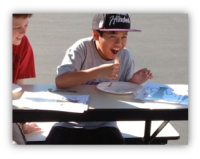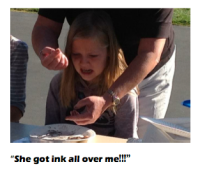Last week, 4th and 5th grade students competed in Round 1 of the Camarillo Academic Olympics. Students could choose up to three of the following categories: Art, California History, Current Events, Creative Writing, English Grammar, Geography, Math, Science, Speech, and US History. More than 180 students participated. (Scroll to the end to view a full photo gallery.)
 Competition started last Wednesday with the Art and Creative Writing categories. Art competitors had an hour and fifteen minutes to compose and draw a still life from five ordinary objects. Entries were judges based on composition; drawing techniques like shading, proportion, and perspective; and the overall impression of the piece. Creative writing participants were also given an hour and fifteen minutes to write a story. Each student could choose one of three story leads. The judges were very impressed with the students’ use of figurative language, dialog, creative plots, and sophisticated vocabulary.
Competition started last Wednesday with the Art and Creative Writing categories. Art competitors had an hour and fifteen minutes to compose and draw a still life from five ordinary objects. Entries were judges based on composition; drawing techniques like shading, proportion, and perspective; and the overall impression of the piece. Creative writing participants were also given an hour and fifteen minutes to write a story. Each student could choose one of three story leads. The judges were very impressed with the students’ use of figurative language, dialog, creative plots, and sophisticated vocabulary.
Thursday was the big day for subject tests. Thirty minutes was allotted for each twenty-five question multiple choice test. You could have heard a pin drop in the MPR as more than 80 students completed their exams. It was equally quiet in the library where an additional 22 students completed their tests.
The week concluded with the Speech competition. Thirteen students worked hard beginning in December, choosing material, memorizing their stories, and practicing during lunches to polish their voices and gestures. All the kids improved so much in the last couple weeks and did an amazing job!
After a weekend on pins and needles, the winners were announced yesterday. In the classrooms, participants received recognition with a certificate of participation. The top three winners in each class received ribbons. Finally it was time for the school winners to be announced. Mrs. Williams, read the winners to the whole school on Monday afternoon. The kids walked to the office to get their extra big ribbons and have their picture taken.
Congratulations to all of our winners:

Math Winners: Shea, 2nd; Manas, 1st; Haley, 2nd, Justin, 2nd; Matt, 2nd; Armando, 2nd (not pictured)
All of our school winners will represent La Mariposa in the City Prelimaries held at the Boys & Girls Club the first week in February. Good luck, Tigers!
Thank you to all the volunteers that proctored tests, graded tests, and wrote on certificates. Special thanks to Dorothy Hanchey, Nichole Sadowsky, Christy Pantoja, and Kathryn Masci for their above and beyond behind the scenes work…we never could have done it without you! Finally a big tiger hug to the La Mariposa office staff for being extra accommodating during last week’s events.



















































































































